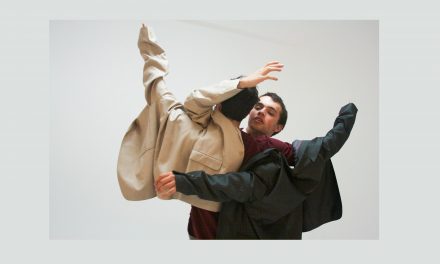The Blaktinx Festival celebrated its return to live performance at the historic Leimert Park Plaza in South Central Los Angeles. In its eighth year, co-producers Licia Perea (Latina Dance Project) and Alicia Adams (Rampart Theater Project – Bootleg Theater) presented an eclectic program of works from 20 local Black and Latinx choreographers. Perea and Adams created the festival in 2013 to “diversify [Los Angeles dance] programming and audiences” and, more importantly, give Latinx and Black choreographers an opportunity to show works that celebrate, highlight, confront, and give voice to their experiences.
The work was personal. On a bare black stage open under the Los Angeles sky, choreographers spoke to healing and community among black women (Akasi Francis-Mora’s “We Are Healers” and Mia Berber’s “She is Her, Her is Me”), navigating identity and belonging (Marlene Garcia and Juan “Co-eL” Rodriguez’s “Ni de Aquí Ni de Allá” and Vannia Ibarguen and Dorcas Roman’s “Clandestine (excerpt)”), honoring ancestral wisdom and legacy (Edgar Aguirre’s “When the Boy Sang” and Shantel Ureña’s “Generational Wealth: Chapter on Mariposas”), confronting pain (Santiago Rivera’s “The Bullet” and Friidom Dunn’s “Stimulus Et Reparations”), and celebrating life and love (Melesio A. Aceves’ “Inanimate” and DaanseKou Cultural Arts Collective of Los Angeles).
Keilah Glover opened the festival with her homage to the Historically Black College and University (HBCU), a bedrock of the black academic experience. “Homecoming” highlighted the infectiously classic movements of the HBCU drum major and majorette, whose music and dancing electrify athletic events in the spirit of rivalry and camaraderie at black academic institutions. Akasi Francis-Mora’s performance was captivating. In “We Are Healers,” Francis-Mora’s movement effortlessly transitioned between sinuous, torso-driven movements, evocative of the Yanvalou, and percussive, segmented “hits” of urban dance expressions like Popping and Krumping.
Alondra Zitlaly Perez was a delight in her solo, “in reach.” Perfectly paired with the longing of Billie Holiday, Perez’s flirty, acrobatic solo felt like looking into the thoughts of a woman remembering the delight of her first love.
Shantel Ureña gave an enchanting performance in her solo, “Generational Wealth: Chapter on Mariposas.” The work opened to the sound of water, echoed in Ureña’s beautifully fluid movements in her arms and torso. As a drum track emerges, her movements become urgent and abrupt, as if she is trying to awaken something deep in the earth. As if this entity wakes up and possesses her, she explodes across the stage in sequences filled with fast footwork pulling from House and Samba.
Marlene Garcia and Juan “Co-eL” Rodriguez were powerful in their duet, “Ni de Aquí Ni de Allá.” Exploring the themes of identity and belonging, the two embodied this struggle as they threw themselves in and out of the floor in quick, acrobatic sequences that were book-ended by unexpected pauses. I enjoyed the seemingly reckless, chaotic explosions of creative fits that would lead to unexpected places that always brought the dancers back together.
“When the Boy Sang,” by Edgar Aguirre, was an intriguing piece performed by Andrew Tiamzon, Diána Worby, David Bernal-Fuentes, Sophia Vengelatos, Monica Stephens and Athena Cruz. . Telling a story of drawing from ancestral wisdom, the piece featured a kaleidoscopic experience of duets cascading into quartets into group sections back into duets and group sections again. The choreographic staging along with the lineal vocal storytelling by artists Chancha and José Larralde made this short, narrative work a delight to watch.

Mia Berber, Angel Anderson, Aryeal Lands, Bianca Ramirez, Elizabeth Altamirano, Jovahana Soladinez and Milagritos Godina – She is Her, Her is Me – Photo by Christopher Martinez
The true highlight of the evening was “She is Her, Her is Me,” by Mia Berber. These. Women. Danced. From the beginning to the end, it was non-stop action in this free-spirited, I-know-exactly-who-I-am-and-I-love-all-of-it homage to female solidarity and triumph. Quick percussion characterized this energetic piece filled with dynamic footwork, popping, twisting torsos, and glorious vibes.
The festival was a beautiful display of often unheard voices and stories throughout Los Angeles. There is so much beauty in these artists. The stage was filled with heart as the performers danced about heritage, culture, custom, and community. In several of the works, I wanted to see more finish and attention to detail in matters like the transitions between music, how the dance ends, and how dancers get on and off the stage. These issues are like the background characters in choreography. When they work as they should, you may not notice them but they are essential to the gestalt of the piece. When they don’t work as they should, they are all you notice, breaking the piece apart and distracting the viewer from a truly immersive experience. I wanted to get lost in their stories, in the physical expression of their thoughts. Instead, I was pulled out by small, unfinished details. Nonetheless, I appreciated every performer and look forward to the continued lifting of these voices. Even more, I look forward to the day when such a festival is no longer necessary.
To learn more about BlakTinx Festival, please visit their website.
Written by Marlita Hill for LA Dance Chronicle.
Featured image: Edgar Aguirre – “When The Boy Sang” – Photo by Jazley Faith









